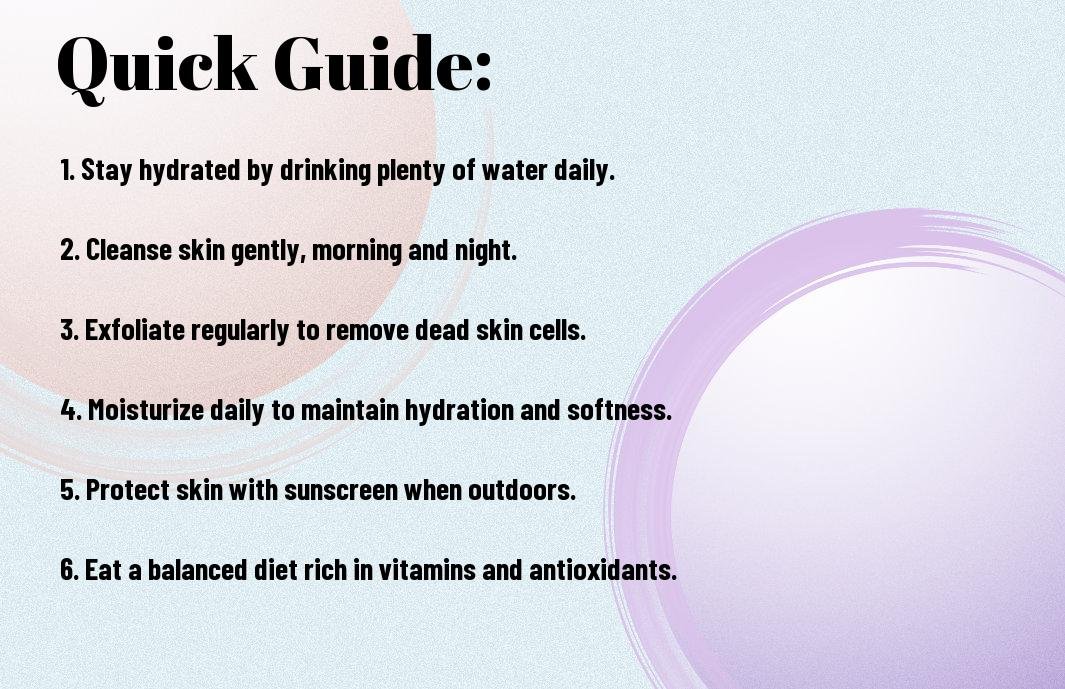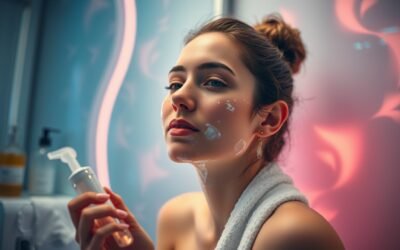Skin can be your canvas of beauty, and achieving silky texture doesn’t have to be complicated. By incorporating simple habits into your daily routine, you can enhance your skin’s health and radiance. This guide will enlighten you on crucial practices that nourish your skin, eliminate harmful habits, and promote an overall sense of well-being. With dedication and the right strategies, you can transform your skincare routine, leading to luminous, smooth skin that radiates confidence.
Table of Contents

How To Achieving Silky Skin with Simple Habits?
Key Takeaways:
- Hydration: Drink plenty of water daily to keep skin hydrated and maintain its elasticity.
- Moisturization: Apply a good quality moisturizer regularly to lock in moisture and create a protective barrier.
- Exfoliation: Incorporate gentle exfoliation into your routine to remove dead skin cells and reveal smoother skin.
- Sun Protection: Use sunscreen every day to shield skin from harmful UV rays and prevent premature aging.
- Balanced Diet: Consume a diet rich in fruits, vegetables, and healthy fats to nourish skin from the inside out.
For more in-depth steps on keeping your skin radiant year-round, check out our guide on Best Practices for Daily Skincare.
Types of Skin and Their Needs
Your skin is unique, and understanding its specific type is the first step towards achieving silky skin. Each skin type has distinct characteristics and requires tailored care. Knowing whether you have normal, dry, oily, or combination skin can facilitate appropriate product selection and skincare routines. The following table summarizes the primary skin types and their basic needs:
| Skin Type | Needs |
|---|---|
| Normal Skin | Balanced moisture and hydration |
| Dry Skin | Intensive moisture and nourishment |
| Oily Skin | Oil control and hydration |
| Combination Skin | Variety of products for different areas |
| Sensitive Skin | Gentle, non-irritating products |
Perceiving your skin type can significantly affect your overall skincare routine and the effectiveness of products you choose to use.
Normal Skin
Some people enjoy the balance that comes with normal skin. This skin type typically exhibits a healthy complexion without excessive dryness or oiliness. To maintain this ideal condition, you should focus on a simple skincare routine that includes regular cleansing, moisturizing, and occasional targeted treatments. Ingredients such as hyaluronic acid and antioxidants work well to keep your skin nourished and supported.
Additionally, using sunscreen daily can protect your skin from harmful UV rays. Regular exfoliation, ideally once or twice a week, can also help clear away dead skin cells and promote a smooth, glowing appearance.
Dry Skin
Little do many realize that dry skin can lead to discomfort and visible flakiness if not properly cared for. This skin type often feels tight, especially after washing, and might present itself as rough or dull. To combat dryness, it’s necessary to incorporate a rich moisturizer into your daily routine that locks in hydration. Look for ingredients like ceramides and glycerin, which can help reinforce your skin barrier. For further insight, check out our guide on How to Hydrate and Care for Dry Skin.
Additionally, you should consider using a gentle, hydrating cleanser that avoids stripping your skin of its natural oils. Regularly applying a hydrating serum with ingredients like vitamin E and aloe vera can significantly contribute to improving skin texture and hydration levels.
It’s crucial to also provide your skin with adequate protection from the environment, as harsh weather can exacerbate the condition of dry skin. Utilize hydrating facial oils or creams during colder months to shield against moisture loss.
Oily Skin
Their oiliness can often make some individuals feel self-conscious, but oily skin also has its advantages. This skin type has a natural glow and is typically resilient against aging. However, it requires careful management to prevent issues like excess shine, enlarged pores, or breakouts. You should consider using oil-free or non-comedogenic products to avoid clogging your pores. For helpful product suggestions, explore our article on Top Oil-Free Products for Oily Skin.
Incorporating exfoliation into your skincare routine—especially with salicylic acid—can help keep the skin clear by reducing excess oil and unclogging pores. Regular use of clay masks can also be beneficial in drawing out impurities and controlling shine.
To manage oily skin effectively, focus on creating a routine that combines hydrating lightweight moisturizers with proper cleansing. Consider including a toner with witch hazel or tea tree oil to help with oil control and tightening pores without stripping moisture.
Combination Skin
There’s a common experience among people with combination skin, where different areas of the face exhibit unique characteristics. For instance, your T-zone may be oily while your cheeks feel dry. This means your approach should involve a mix of strategies tailored to meet the diverse needs of your skin. You may want to use lighter products for the oilier areas and more nourishing formulations for the drier sections. For a more customized approach, read our Ultimate Skincare Guide for Combination Skin.
It’s beneficial to focus on a balanced routine that addresses both needs, such as a gel-based cleanser paired with a rich moisturizer only on the drier areas. A targeted treatment approach can result in a well-rounded skincare routine that minimizes oiliness while still keeping dry patches adequately hydrated.
Skin that fluctuates between oily and dry can often benefit from custom solutions tailored specifically for combination skin. You might consider using multipurpose formulas that serve to balance different areas while providing the specific hydration needed.

Essential Tips for Silky Skin
After integrating a few simple habits into your routine, achieving silky skin becomes more attainable than ever. It’s about understanding the fundamental steps to enhance your skincare goals. Here are some important tips to get you started:
- Keep your skin thoroughly hydrated.
- Incorporate regular moisturization.
- Practice effective sun protection.
- Pay attention to your dietary choices.
Knowing how to balance each of these areas sets the foundation for glowing skin. For deeper insights, consider exploring Unlocking the Science Behind Silky Skin: What Experts Say.
Hydration and Moisturization
To achieve that enviable silky skin, your journey begins with proper hydration. Water, both inside and outside your body, plays a fundamental role in maintaining skin elasticity and overall health. It’s important to drink enough fluids throughout the day and consider adding hydrating foods like cucumbers and oranges to your diet. For more hydration insights, check out our article on 5 Best Foods to Keep Your Skin Hydrated.
Additionally, consistent moisturizing helps trap moisture in your skin, preventing dryness and flakiness. Look for products that suit your skin type, and try to apply them immediately after bathing for maximum effect. By making intensively hydrating skincare a routine, you set a layer of protection against environmental damage.
Sun Protection
Clearly, your skin’s health can be dramatically affected by sun exposure. UV rays can lead to premature aging and skin damage, making sun protection an indispensable habit. Always opt for a broad-spectrum sunscreen with an appropriate SPF level to shield your skin from harmful rays. For tips on staying protected, see our guide on 3 Common Sun Protection Mistakes to Avoid.
It’s not just about sunny days; even on overcast or winter days, UV rays can penetrate clouds and harm your skin. Therefore, daily application is vital, ensuring that your skin remains safeguarded throughout the year. It’s wise to reapply every two hours if you’re outdoors, giving your skin the best chance to thrive.
Dietary Considerations
On your journey towards silky skin, dietary choices play a significant role in how your skin looks and feels. Incorporating a balanced diet rich in antioxidants can enhance your skin’s resilience and radiance. Abundant in fruits and vegetables, these foods help combat oxidative stress and inflammation, leading to healthier skin overall. For dietary guidance, read our post on 7 Foods That Boost Your Skin’s Health.
Understanding the types of foods that support skin health is important. For instance, omega-3 fatty acids found in fish can help maintain your skin’s moisture balance, while protein-rich foods support skin repair. By focusing on whole foods and minimizing processed options, you create a nourishing environment that promotes a smoother, silken appearance.
Step-by-Step Guide to Achieve Silky Skin
Not only does silky skin enhance your overall appearance, but it also boosts your confidence. To achieve this desired texture, you need to cultivate a few crucial habits that become part of your routine. Below is a comprehensive table outlining some key steps to incorporate into your daily skincare regimen.
| Step | Description |
|---|---|
| Hydration | Drink at least 8 glasses of water per day to keep your skin hydrated from within. |
| Cleanser | Use a gentle cleanser suited to your skin type to remove impurities. |
| Moisturizer | Apply a nourishing moisturizer before beginning your day. |
| SPF Protection | Always apply sunscreen to prevent sun damage and maintain your skin’s softness. |
Morning Routine
Guide your skin towards its softest state by starting your day with a simple yet effective morning routine. Begin by cleansing your face to remove any oils accumulated overnight. Follow this up with a hydrating toner that balances your skin’s pH. After toning, gently pat a moisturizer onto your skin, ensuring it absorbs well for a smooth finish. By also applying a broad-spectrum SPF, you protect your skin against UV damage, which is vital for maintaining its softness. For a deeper dive into optimizing your morning steps, explore “5 Key Morning Skincare Steps for a Radiant Glow”.
Investing just a few minutes each morning can lead to remarkable results. You’ll find that dedicating time to your skin will not only give you instant hydration but can help maintain the silky feel throughout the day. As you make these routines a habit, you will notice your skin becoming healthier and more radiant.
Evening Routine
Clearly, an effective evening routine can significantly impact how your skin feels come morning. After a long day, it’s important to cleanse your skin thoroughly to remove makeup, dirt, and oils that have built up. Use a gentle makeup remover followed by your favorite cleanser. This two-step cleansing process ensures that your pores are free from clogging debris. Next, apply a replenishing serum or night cream that caters to your skin’s specific needs and allows it to repair and rejuvenate overnight. For more on setting up an effective nighttime routine, check out “7 Mistakes to Avoid in Your Night Skincare Routine”.
Taking the time to pamper your skin in the evening leads to smoother, healthier skin. The night is your skin’s time to recover, so use it to your advantage by adopting cutting-edge products designed for overnight hydration and renewal.
Another crucial aspect of your evening routine is ensuring you prepare your skin for a good night’s sleep. Use products that are rich in antioxidants and hydrating agents, allowing your skin to absorb crucial nutrients while you rest. This proactive approach paves the way for visibly softer, more supple skin in the morning.
Weekly Treatments
Assuming you desire truly radiant skin, incorporating weekly treatments is fundamental to your journey. This can include exfoliating masks that eliminate dead skin cells, allowing newer, fresher skin to emerge. Exfoliation helps to improve texture and promotes a more vibrant appearance. Additionally, consider using moisturizing facials that deeply hydrate, replenishing your skin’s moisture barrier to enhance its silky feel. To ensure you’re on the right track, explore “3 Essential Weekly Treatments for Glowing Skin”.
Scheduling these weekly treatments can prove to be a game-changer for your skin’s health and overall smoothness. By dedicating time each week to these treatments, you’ll notice the cumulative effect they have, leading to remarkable improvements in your skin’s texture.
Morning exfoliation is another critical factor in enhancing the overall softness of your skin. Choose gentle products that suit your skin type, as aggressive treatments can lead to irritation and diminished softness. Therefore, ensure your skincare regimen remains gentle yet effective for continued silky skin success.
Factors Affecting Skin Texture
Once again, the way your skin feels and looks can be influenced by various factors. Understanding these can help you retain and achieve that desired silky skin. Here are some key elements to consider:
- Environmental impacts
- Hormonal changes
- Lifestyle choices
Thou must pay attention to each of these factors to enhance your skin’s texture.
Environmental Influences
Little things in your environment can greatly impact your skin. From the climate you live in to the products you use daily, environmental factors play a significant role in your skin’s condition. For instance, exposure to the sun’s harsh UV rays can lead to premature aging and a rough texture. Air pollution can clog pores and create an uneven skin tone. Therefore, it’s paramount to protect your skin from detrimental elements, using high-SPF sunscreen and keeping your skincare routine suitable for your environment. For more tips on protective skincare, see our article on “Top 5 Environmental Skin Hazards to Avoid”.
When you are aware of these environmental influences, you can make informed decisions that will keep your skin radiant and smooth. Keeping your skin well-hydrated and using protective barriers are also necessary steps to combat these external factors.
Hormonal Changes
With the ebb and flow of hormones in your body, your skin texture can fluctuate significantly. This is particularly true during periods of puberty, menstruation, and menopause, when hormonal levels can disrupt your skin’s natural balance. An increase in oil production can lead to breakouts, while hormonal imbalances can cause dryness and flakiness. To manage these shifts, check out “5 Effective Skincare Tips for Hormonal Changes”.
Plus, recognizing how these hormonal shifts affect your skin can empower you to adapt your skincare routine accordingly. You may need to incorporate products that target acne during certain phases of your cycle or switch to more hydrating formulas when dry patches appear.
Lifestyle Choices
To achieve that silky skin, your daily lifestyle choices should align with your skincare goals. Factors such as your diet, hydration, and stress management techniques can contribute to the overall texture and appearance of your skin. Consuming a poorly balanced diet or overlooking your water intake can result in lackluster skin, while excessive stress can lead to hormonal fluctuations that manifest as skin issues. For more guidance, consider reading “7 Bad Habits That Harm Your Skin”.
The way you care for your skin on a daily basis will have a lasting impact. Incorporating nutrient-dense foods, drinking plenty of water, and finding effective stress relief methods, like meditation or exercise, can work wonders for your skin’s condition. With the right choices and habits, you can create an environment that fosters beautiful, silky skin.
Pros and Cons of Popular Skin Products
All skin products, whether natural or commercial, come with their own set of advantages and drawbacks. Understanding these can empower you to make informed choices suitable for your unique skin needs. Below is a breakdown of the pros and cons of some popular skin products.
| Pros | Cons |
|---|---|
| Increased hydration and moisture retention. | May cause irritation for sensitive skin. |
| Formulated with beneficial ingredients like vitamins and antioxidants. | Some contain harmful chemicals or irritants. |
| Can lead to a more even skin tone. | Results can be inconsistent based on skin type. |
| Often designed for specific skin issues, like acne or aging. | Can be expensive, particularly for high-end brands. |
| Convenient and easy to use. | May contribute to product buildup on the skin. |
| Backed by scientific research and clinical trials. | Some products may not be cruelty-free or eco-friendly. |
| Variety of formulas available to suit different preferences. | Can create reliance on products for skin health. |
| Often have a pleasant scent or luxurious texture. | Possible allergic reactions to fragrance or other ingredients. |
| Offers instant results like glow and softness. | Long-term use may lead to dependency. |
| Expert guidance and recommendations are readily available. | May not address underlying causes of skin problems. |
Natural Remedies
Remedies for achieving silky skin can often be found in your own kitchen. Natural ingredients like honey, oatmeal, and coconut oil boast nourishing properties that can hydrate and soften your skin effectively. By incorporating simple mixtures, such as a honey and sugar scrub or a coconut oil moisturizer, you can create your own skincare routine without any harsh chemicals. These remedies not only allow you to avoid synthetics but also often save you money in the long run. For more ideas, see our article on “5 Amazing Natural Ingredients for Perfect Skin”.
Another benefit of opting for natural remedies is that they reduce the risk of allergic reactions or skin irritation that can arise from commercial products. Plant-based ingredients typically contain vitamins and antioxidants that work harmoniously with your skin. However, it’s important to do a patch test on a small skin area before fully applying any new treatment to ensure it suits your complexion.
Commercial Skincare Products
When it comes to commercial skincare products, the wide variety available on the market can be overwhelming. These products are often formulated with cutting-edge technology and specialized ingredients aimed at targeting specific skin issues like aging, dryness, or acne. They can provide quick results and may be backed by research, giving you confidence in your purchases. For a deeper look, see our guide on “10 Pros and Cons of Commercial Skincare Products”.
Pros of commercial skincare products often include their ability to deliver quick results, as many contain potent active ingredients designed for skin improvement. However, it is important to scrutinize the ingredients list—some products may hold potential risks due to elements that can cause irritation or allergic reactions. Additionally, while many commercial options can be transformative, always seek products that prioritize safety, using terms like dermatologist-tested and non-comedogenic. Ultimately, ensuring that you choose products aligned with your skin’s unique needs can pave the way toward achieving that silky texture you desire.

Lifestyle Habits for Maintaining Silky Skin
For achieving and maintaining silky skin, your daily habits play a significant role. You can learn more about effective skincare behaviors by exploring insights from others on [Misc] what are good simple habits you’ve kept up that have …. Implementing these habits into your lifestyle can lead to visible improvements in your skin’s texture and appearance. Some minor adjustments to your routine can foster not only healthier skin but also enhance your overall well-being.
Exercise and Its Benefits
Exercise stimulates blood circulation, which allows for better nutrient delivery to your skin cells while promoting the removal of toxins. Engaging in regular physical activity can aid in the production of collagen, a protein that keeps your skin supple and youthful. Coupled with enhanced oxygen flow, exercise can output a natural glow to your complexion, making your skin look more vibrant and rejuvenated. For more insights on fitness and skin health, see our article on “5 Top Exercises for Radiant Skin”.
Sleep and Skin Health
An adequate amount of sleep is vital for your skin’s health. During the sleep cycle, your body goes into repair mode, allowing for cell regeneration and recovery. As you sleep, the skin produces collagen, preventing drooping and sagging, which can lead to a smoother and more youthful appearance. Prioritizing good sleep hygiene can lead to a visible improvement in your skin’s texture and appearance. For helpful tips, explore “10 Best Sleep Habits for Better Skin”.
Plus, poor sleep can result in various skin issues, such as increased dryness, worsening of skin conditions, and the formation of dark circles. Ensuring you receive enough restorative sleep can enhance your overall skin quality and contribute to a less stressed, more even complexion.
Stress Management
Skin often reflects your internal health, and managing stress is imperative for maintaining silky skin. High levels of stress can lead to increased production of cortisol, a hormone that can disrupt your skin’s balance and trigger issues like acne or inflammation. Developing effective stress-reducing techniques such as mindfulness, deep breathing exercises, or gentle yoga can assist in keeping both your mind and skin calm. For more on this topic, check out “5 Effective Stress-Relief Techniques for Healthier Skin”.
A good approach to stress management is to incorporate regular breaks into your day. Simple strategies, like spending time outdoors, nurturing hobbies, or engaging in creative pursuits, can significantly reduce stress levels and lead to improvements in your skin health. By finding the balance between life’s challenges and maintaining your well-being, you will notice noticeable positive changes in your skin’s appearance.
Summing up
Now that you understand the fundamental habits required for achieving silky skin, it’s time to implement these practices consistently in your daily routine. Prioritizing hydration through proper water intake and selecting products enriched with skin-loving ingredients can significantly enhance your skin’s texture. Additionally, adopting a gentle cleansing routine and incorporating regular exfoliation will help remove dead skin cells and promote a smoother appearance. By being mindful of your diet, focusing on nourishing foods, and protecting your skin from harmful UV rays, you can elevate your skincare journey to new heights.
As you embrace these simple habits, give yourself the grace to adapt and discover what works best for your unique skin type. Consistency is key, and over time, your efforts will translate into that desired silky feel you seek. Keep in mind that every small step makes a difference, so stay committed to your skincare routine, and soon enough, you’ll be boasting the radiant and smooth skin you desire.
FAQ:
Q: How can hydration affect the texture of my skin?
A: Staying well-hydrated is key to achieving silky skin. When your body is adequately hydrated, your skin appears more plump and elastic, reducing the appearance of dryness and flakiness. Aim to drink at least 8 glasses of water a day and include hydrating foods like cucumbers and watermelon in your diet.
Q: What skincare products are best for achieving silky skin?
A: Incorporating products that contain moisturizing ingredients like hyaluronic acid, glycerin, and natural oils can help achieve silky skin. Look for creams and serums labeled as ‘hydrating’ or ‘moisturizing.’ Additionally, using gentle exfoliants like AHA or BHA can remove dead skin cells, revealing a smoother surface.
Q: How often should I exfoliate for optimal results?
A: Exfoliating 1-2 times a week is generally sufficient for most skin types. Over-exfoliating can lead to irritation and compromised skin barrier, which can instead result in dryness. Choose a gentle exfoliating method that works well with your skin type, and adjust frequency according to your skin’s response.
Q: Are there specific foods that promote silky skin?
A: Yes, certain foods can enhance skin health and promote a silky texture. Incorporate foods rich in antioxidants, such as berries, nuts, and green leafy vegetables, as well as healthy fats from avocados and fish. These nutrients help support overall skin health and hydration.
Q: How can lifestyle habits contribute to silky skin?
A: Lifestyle choices can significantly impact your skin’s appearance. Ensure you get adequate sleep, manage stress, and protect your skin from sun damage. Regular physical activity also boosts circulation, delivering vital nutrients to the skin and enhancing its overall radiance and texture.



























0 Comments